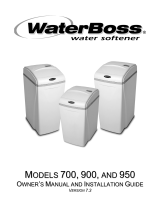
NEED HELP? GIVE US A CALL 855.424.9892
15
INSTALLATION
DISPLAY SETTINGS
UNITS: Select English or Metric
TIME: Set the current time of day
REGEN TIME: Set the regeneration time, if
using the Delayed Mode.
REGENERATION SETTINGS
Choose the settings best for your household.
TYPE:
High Capacity - Softener will regenerate less
often, but will use more salt.
High Efciency - Softener will regenerate more
often using more water, but less salt. This is
the default. This setting meets or exceeds the
requirement some states have for efciency.
Automatic - Uses the average daily water usage
to determine salt usage and regeneration cycles.
Recommended for large households or those with
high levels of water hardness.
MODE:
Demand - Triggers a regeneration as soon as
softening capacity is exhausted. This is the default.
Delayed - Allows regeneration at a specic time
(ex. 2 A.M. when less water is typically being used).
ALARM SETTINGS
LOW SALT: Select On or Off.
MODEL 400T/450T: Every time salt is added to
brine cabinet, press Salt Level button on home
screen. Make sure arrow on the level indicator
matches salt level present in brine cabinet.
Once controller calculates that more salt is
needed, it will begin beeping and will display
Low Salt Alert screen. Press “OK” button to
silence beeping and return to home screen.
Salt Level button will be ashing “ADD”. After
salt is added to brine cabinet, remember to
press Salt Level button to reset salt level.”
MANUAL REGENERATION
User can press “REGEN” button to force an
immediate regeneration. The “NEXT” button
that appears on the screen allows the user to
advance the cycle to the next position.
Main Menu
FACTORY RESET
On Main Menu screen there is a button labeled
“RESET”. Pressing this button brings up Restore
Defaults screen. Pressing “Yes” will return
controller to factory default settings.
OVERRIDE
Press [<] to turn on. If “96 Hour” is selected,
unit will work no more than 4 days without a
regeneration. Default is “96 Hour” to be off.
Leave this on if you have iron in your water.
WI-FI SETTINGS (ONLY for model 450T)
Privacy Policy Consent - User must say Yes to
access the following screens.
Status - Connected or Not Connected.
Network - Select the network name from a list
or manually select the Network SSID.
Password - Enter the password.
Low Salt - When the controller determines salt
level is low, an alert screen will appear and the
controller will beep. User will press the “OK”
button to silence the beeping. Additionally, if
using Wi-Fi controllers, an email will be sent. The
Salt Level icon on the Main Menu home screen
will ash “ADD”. When user presses the Salt Level
icon, the Salt Level screen will appear. When salt
is added, user will input how much salt is in the
cabinet and press “ACCEPT” button. Controller
will then reset to show Salt Level = OK.
Low Temperature - When the controller detects
temperatures close to freezing (below 40°F/4°C),
an alert screen will appear and the controller
will beep. The user will hit the “OK” button to
silence the beeping. Additionally, if using Wi-Fi
controllers an email will be sent. When the
temperature rises above the low temperature
threshold, the controller will automatically reset
alarm and stop beeping.
Water Usage - If controller detects water owing
for 60 minutes without stopping, an alert screen
will be shown and controller will beep.
1. On the home screen, press the “MENU” button.
2. On the Main Menu screen, press the button for “Hardness”.
3. On the Water Hardness screen, press the “+” button to increase hardness or “-“ button
to decrease hardness. Input the compensated hardness determined by your water test.
4. Press the “SAVE” button to save the value and return to the Main Menu screen.
5. Press the “BACK” button to return to the home screen.
The Main Menu screen has other options if you choose to change the factory default settings.
Depending on the model, not all options will apply. The controller should only display
options available to the model for which it is programmed.
STEP 10 Setting the Controller
























